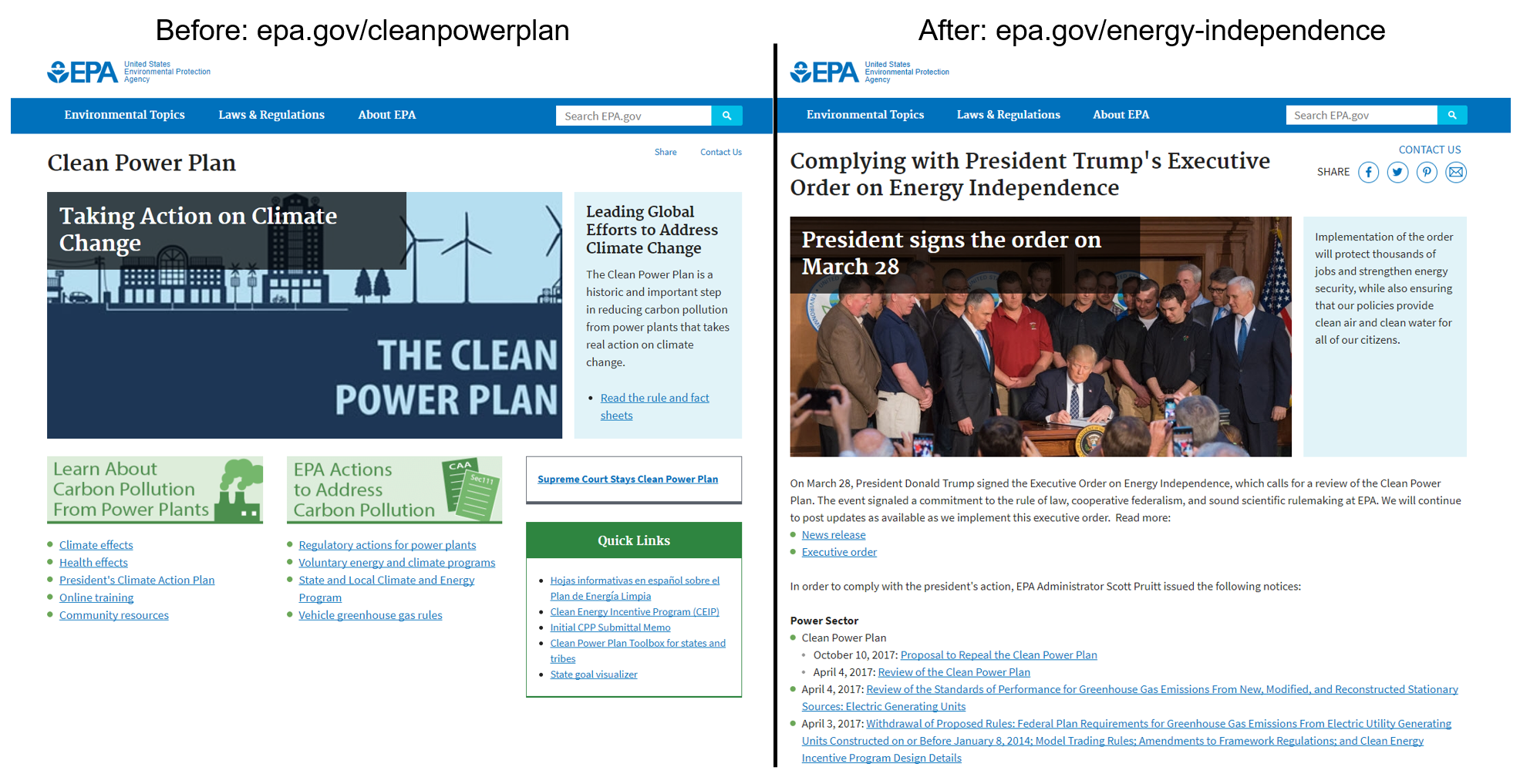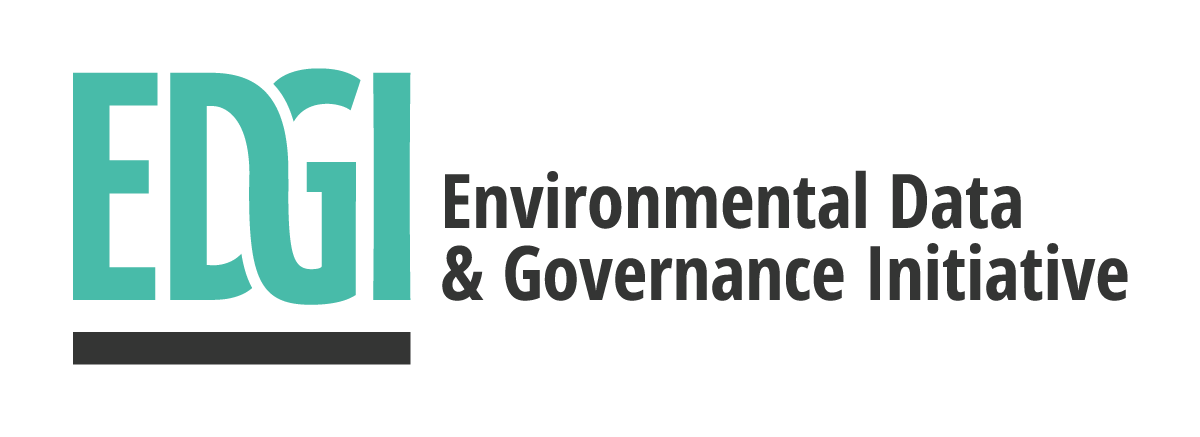By Toly Rinberg and Andrew Bergman, members of EDGI’s Website Monitoring Committee
Originally posted on the UCS Equation
On Monday, Scott Pruitt, Administrator of the Environmental Protection Agency, announced his long awaited formal proposal to repeal the Clean Power Plan, the defining regulation in President Barack Obama’s battle against climate change. Talk of the repeal has made headlines for months, after President Donald Trump’s executive order addressing energy and climate policy and his announcement that he intended to withdraw from the Paris Climate Accord. News about a potential replacement for the rule has swirled for weeks.
Yet amid all of the discussion, the Web resources and information that the government has long provided to help inform us about climate change, the social cost of carbon, and the Clean Power Plan itself have been disappearing from federal websites. For members of the public looking to learn about the science and the policy analyses that underlie years of rulemaking and debate, the sources have become harder to find. We’ve found and reported on a number of examples of these types of removals through our work monitoring federal websites at the Environmental Data & Governance Initiative.
Web resources gone missing
After the EPA’s announcement on April 28 that it would be overhauling its website to “reflect the agency’s new direction under President Donald Trump and Administrator Scott Pruitt,” most of the sections of EPA.gov devoted to climate change and work to adapt to and mitigate its harms were removed. While most of these resources were archived, few have been returned or replaced on the official EPA website, where they can be most easily accessed. Certain portions, like “A Student’s Guide to Global Climate Change,” never even made it into an EPA Web archive, likely due to copying errors.
During the same set of EPA website removals, the website for the Clean Power Plan was itself removed and its URLs began redirecting to a new website about implementing President Trump’s executive order. While the previous website hosted resources for the public to understand the Clean Power Plan and for states to develop emissions plans, the new website links to the Federal Register, the order notice, and related news releases, but provides minimal informational resources directed at communicating the significance of the policy shifts to the public. The previous website linked to Spanish language Web resources, like Clean Power Plan facts sheets and community resources, which were also removed without being archived, likely as a result of the same errors mentioned above.

In Administrator Pruitt’s announcement and in the proposed repeal itself, Obama-era analyses of the potential health benefits of the rule and the overall social cost of carbon have been questioned and tossed aside. The information and resources that could provide the public insight into this debate have, once again, been removed: the EPA’s webpage on the social cost of carbon was part of the April 28 removals and the White House webpage on the topic, containing a wealth of relevant links, was removed and archived on inauguration day.
The legal basis for the requirement that EPA regulate greenhouse gas emissions, known as the endangerment finding, is another crucial resource in understanding the debate over the rule. But the EPA’s endangerment finding webpage, too, was swallowed up by the April 28 removals, and has since been either hard to access or, at times, simply not available.
The importance of well-informed public comment
Notice-and-comment rulemaking, used by the federal government whenever it puts new regulations in place or removes existing ones, relies on the ability of the public to provide informed input about the ways in which we will all be affected by a new regulation and how we weigh the costs and benefits. Public comment dockets today are often dominated by industry groups and civil society organizations. Making government-funded information harder to access simply serves to further the divide between those who have the capacity to craft a substantive public comment and those who do not.
A scientist or member of the public working on their own time to write a public comment, relying only on public information resources, can make an impact, as their comment has equivalent standing to any other submission and must be accounted for just the same. The public information that the government has historically made available about the Clean Power Plan’s projected air quality improvements, for example, would provide a way for people to weigh in on the debate over how to value the regulation’s predicted health benefits. But without access to public information, we’re allowing the idea of regulation with citizen input to become nothing more than a myth.
The likely replacement for the Clean Power Plan, if there is one, will be designed to masquerade as a sufficient regulation of emissions in order to evade litigation. Instead of a comprehensive rule like the Clean Power Plan, regulating pollution from coal power plants by considering wholescale how they use energy and produce emissions, it will likely focus only on reducing pollution through improvements in efficiency or fuel replacements at individual power plants. Past EPA studies have determined that these types of changes would result in only an approximate 4% increase in coal plant efficiency.
After approving the proposed repeal on Tuesday, Administrator Pruitt said, “Any replacement rule will be done carefully, properly, and with humility, by listening to all those affected by the rule.” It’s clear from his Administration’s removal of Web resources, however, that he has no intention of enabling that pledge by ensuring that public resources remain available to help citizens understand the proposed policy shifts.
When the health and well-being of the public are threatened so directly by the harms of climate change, we cannot allow our government to censor the information that facilitates the public’s crucial expression in forming new policy.
How you can make an impact
While an overturn of the proposed repeal is unlikely, it is still important that we, as members of the public, weigh in on the benefits that the Clean Power Plan would have to the climate and public health. What we have to say must be taken into account during the rulemaking process and will bolster any litigation that occurs after the repeal.
Once the Federal Register publishes the Notice of Proposed Rulemaking in the coming days, the public will have 60 days to submit comment. Find out how to submit a comment here.
Here are resources about the Clean Power Plan and its benefits, some mentioned above, that have been removed from federal websites and can be used to craft your comment:
- Clean Power Plan Summary, History, and Additional Resources (EPA’s Web archive)
- Spanish-language Clean Power Plan Fact Sheets (No EPA Web archive)
- Clean Power Plan Toolbox for States (EPA’s Web archive), with technical resources estimating the impact of energy efficiency efforts and reducing carbon emissions
- Social Cost of Greenhouse Gases (White House Web archive)
- EPA’s Climate Change Website (EPA’s Web archive), including:
